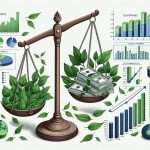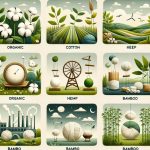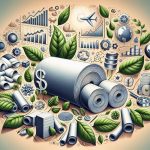Did you know that investing in sustainable fabrics can actually save you money in the long run? While the initial costs might seem higher, these fabrics are built to last, reducing the need for frequent replacements. Beyond just cost savings, they also align with the growing consumer demand for eco-friendly products. By adopting sustainable fabrics, brands can gain a competitive edge in the market. But how exactly does this translate into financial viability for businesses?
Table of Contents
Key Takeaways
- Sustainable fabrics offer long-term cost savings by reducing the need for frequent replacements.
- Eco-friendly production processes minimize waste and increase efficiency, enhancing financial viability.
- Compliance with environmental regulations avoids potential fines and legal risks, ensuring economic stability.
- The growing consumer demand for sustainable products boosts brand loyalty and market share.
- Investing in sustainable fabrics differentiates brands, enhancing reputation and mitigating resource scarcity risks.
Cost Comparison
When comparing costs, sustainable fabrics might appear pricier upfront but can save you money in the long run. You might wonder how that's achievable. Well, let's break it down.
Sustainable fabrics are designed with minimal environmental impact in mind. Their production processes often integrate advanced technologies that enhance production efficiency, reducing waste and conserving resources. This initial investment in better materials and processes means you're getting a product that's built to last. Over time, you'll find that these fabrics maintain their quality and durability, reducing the need for frequent replacements.
Moreover, sustainable fabrics often come from renewable resources, which means the environmental cost is lower. Traditional fabrics might be cheaper initially, but they often require significant amounts of water, pesticides, and energy, leading to a higher long-term cost when you factor in environmental degradation and resource depletion.
Market Trends
As sustainable fabrics gain popularity, market trends are shifting towards eco-friendly and ethically produced materials. You're seeing a surge in demand for fabrics that minimize environmental impact and utilize innovative production methods. This momentum is driven by heightened global market awareness and stricter regulations promoting sustainability.
| Trend | Description | Impact |
|---|---|---|
| Eco-Friendly Fibers | Fabrics from organic or recycled materials | Reduced waste and pollution |
| Ethical Production | Fair labor practices and humane working conditions | Enhanced brand reputation |
| Technological Advancements | Innovations in sustainable production methods | Increased efficiency |
| Regulatory Compliance | Adherence to international sustainability standards | Market access and growth |
Your awareness of these trends is essential. Eco-friendly fibers, like organic cotton or recycled polyester, are gaining traction because they significantly reduce waste and pollution. Ethical production ensures fair labor practices, elevating brand reputation and consumer trust. Technological advancements in production methods not only enhance fabric quality but also boost efficiency, reducing costs in the long run.
Keeping up with regulatory compliance is non-negotiable. Regulations in the global market are becoming more stringent, pushing companies to adopt sustainable practices or risk losing market access. By understanding these trends, you can better navigate the evolving landscape of sustainable fabrics, ensuring your strategies are both forward-thinking and compliant.
Consumer Demand
Driven by heightened environmental awareness, consumers are increasingly demanding sustainable fabrics for their apparel and home goods. You're likely noticing that customer preferences are shifting towards materials with low environmental impact and ethical sourcing. This rising demand is reshaping the textile industry, compelling brands to reassess their supply chains and align with industry standards that prioritize sustainability.
By prioritizing sustainable fabrics, you're not only meeting the current market expectations but also setting a precedent for responsible manufacturing. Ethical sourcing guarantees that the labor used in producing these fabrics adheres to fair trade principles, which, in turn, enhances your brand's reputation and customer loyalty.
The appeal of sustainable fabrics is multifaceted. Consumers are drawn to the reduced environmental impact, knowing their choices contribute to less waste and pollution. You can leverage this by transparently sharing your sustainability efforts, which can cultivate trust and drive higher engagement.
Moreover, as industry standards evolve, aligning with them can give your brand a competitive edge. Implementing sustainable practices isn't just a trend; it's a strategic move that responds to discerning customer preferences. In doing so, you position yourself as a leader in a market increasingly driven by conscious consumption.
Long-Term Benefits
Embracing sustainable fabrics offers long-term benefits that can significantly enhance your brand's resilience and reputation. By committing to materials with reduced environmental impact, you position your brand as a leader in the eco-conscious market. This not only attracts discerning customers but also aligns your business with the growing global movement towards sustainability. Consumers today are more informed and demanding; they seek authenticity and accountability. By integrating sustainable fabrics, you demonstrate your brand's dedication to social responsibility, nurturing trust and loyalty among your audience.
Moreover, adopting sustainable practices helps mitigate risks associated with environmental regulations and resource scarcity. Brands that prioritize eco-friendly materials are better equipped to adapt to future legislative changes and market shifts. This foresight guarantees long-term stability and reduces vulnerability to supply chain disruptions.
Furthermore, showcasing your commitment to sustainable fabrics can differentiate your brand in a crowded marketplace. It highlights your forward-thinking approach, appealing to stakeholders who value ethical practices. This not only strengthens your brand's image but also fosters a culture of innovation and responsibility within your organization.
Ultimately, the long-term benefits of sustainable fabrics extend beyond immediate profits, securing a prosperous and responsible future for your brand.
Financial Viability
Considering the long-term advantages, sustainable fabrics also prove to be financially feasible for your brand. Initially, the upfront costs might appear higher compared to conventional fabrics, but the return on investment (ROI) is more appealing over time. You'll realize that sustainable fabrics often lead to reduced waste and increased production efficiency, translating into cost savings.
Here's a quick comparison to illustrate the financial viability:
| Aspect | Conventional Fabrics | Sustainable Fabrics |
|---|---|---|
| Initial Cost | Lower | Higher |
| Long-term ROI | Moderate | High |
| Production Efficiency | Standard | Optimized |
| Waste Reduction | Minimal | Significant |
By investing in sustainable fabrics, you're not just complying with environmental regulations; you're also setting your brand apart in a competitive market. Customers today are more conscious about their purchases, and they tend to support brands that are environmentally responsible. This enhances your brand's reputation and can lead to increased customer loyalty, further boosting your ROI.
Moreover, sustainable fabrics often come with innovative production techniques that optimize efficiency. These methods reduce energy consumption and minimize waste, leading to lower long-term operational costs. Therefore, choosing sustainable fabrics isn't just an ethical decision; it's a smart financial strategy.
Frequently Asked Questions
How Do Sustainable Fabrics Impact Environmental Conservation?
You'll find sustainable fabrics significantly reduce the carbon footprint and water usage. They also positively affect biodiversity impact and waste reduction, making them essential for environmental conservation. Mastering their benefits is vital for a sustainable future.
What Are the Main Sustainable Fabric Materials Available?
You'll find that the main sustainable fabric materials include organic cotton, bamboo, hemp, and Tencel. These materials boast impressive fabric durability and align seamlessly with current fashion trends, ensuring both longevity and style.
How Is the Quality of Sustainable Fabrics Compared to Traditional Fabrics?
You'll find that sustainable fabrics often match or exceed traditional fabrics in quality. They offer excellent fabric durability, lower environmental impact, and impressive comfort. Though cost effectiveness varies, investing in sustainability often pays off long-term.
Are There Specific Certifications for Sustainable Fabrics?
Yes, there are specific certifications for sustainable fabrics. You should look for certification standards like GOTS and OEKO-TEX. These standards guarantee environmental responsibility and global impact, offering you confidence in the fabric's sustainability and quality.
What Are the Ethical Considerations in Sustainable Fabric Production?
You might think ethical considerations are obvious, but they're not. Focus on labor practices, supply chain transparency, animal welfare, and chemical usage. These factors guarantee sustainability and align with your desire for a deeper understanding.
- Tetron Fabric for Marine Applications: Durability and Use Cases - June 18, 2025
- Tetron Fabric for Outdoor Furniture: Weather Resistance and Care - June 18, 2025
- Tetron Fabric for Wall Coverings: Style and Application Tips - June 18, 2025





